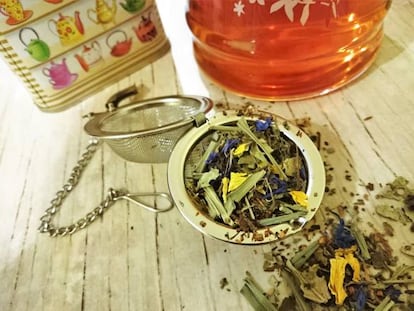Beware of homemade canning: How to do it properly
Poorly canned homemade preserves can cause botulism, a rare but serious illness

For gardeners, there are seasons of the year in which we accumulate so much produce that we don’t know what to do with it. It tends to happen at the end of the summer with tomatoes, peppers, zucchini and other vegetables. To avoid throwing out that food, we can make homemade preserves. Pesto, roasted peppers, tomato sauce and more allow us to keep produce ready to eat for months, giving us food to eat even when it’s out of season.
Homemade canning consists of washing and cutting the food, putting them in jars of liquid (salt water or oil), closing the containers and heating them in a double boiler. After a certain amount of time, they are removed to cool upside-down, ensuring that they are securely sealed. The technique may seem simple. It has been passed down by word-of-mouth for generations. And endless articles and videos online give instructions on homemade canning. The problem is that such instructions tend to omit some aspects that are fundamental to ensure the food’s safety.
It’s not enough merely to follow the aforementioned steps. Proper canning requires controlling the process, maintaining certain precautions and monitoring what is happening at each step. Not even Nicolas Appert, who invented canning through trial and error a few centuries ago, knew this. It wasn’t until years later that, thanks to the work of Louis Pasteur, the basics of food preservation were discovered.
Risks associated with homemade canning
The “secret” of making preserves has to do with two points. First, the heat applied during the process eliminates the microorganisms present (mainly bacteria), which can spoil the food and make us sick. Secondly, the container must be hermetically sealed to prevent the preserves from becoming contaminated.
If not done correctly, they can be contaminated with pathogens. The most concerning one is Clostridium botulinum, a potentially extremely dangerous bacteria that is highly resident to heat, allowing it to survive a homemade procedure if not done well.
The bacteria is present throughout the environment —for example, in the soil or aquatic sediment— and can be present in food. It can develop spore forms that are resistant to conditions that are adverse for most bacteria, such as lack of oxygen, humidity and nutrients. It is also very resistant to high temperatures. Most bacteria are easily eliminated at temperatures above 100ºC, but spore forms of C. botulinum can resist up to 120ºC. That is, boiling the jars at a temperature of 100ºC may not be enough to insure the preserves’ safety.
What can happen if we eat spoiled canned food?
These bacteria produce one of the most toxic compounds known to us: botulinum toxin. (A lethal dose for a 70-kilo person is just 70 micrograms, or 0.000070 grams.) It is a neurotoxin that can provoke muscular paralysis. Most patients recover, but it causes a serious illness, whose recovery period can last for several months. It can cause death via respiratory arrest, particularly if it is not treated in time. It has a mortality rate of between 5% and 10%.
We tend to think, “in my house, we have always made preserves like this, and nothing has ever happened.” That may be true. Fortunately, the most common scenario is that nothing bad happens. In Spain, nine to 12 cases are documented per year, a rate that seems ridiculous if compared to other food-transmitted illnesses, such as Campylobacteriosis (with about 19,000 cases yearly) and salmonella (about 8,000 cases per year). But a risk evaluation must take into account two aspects: the probability of its occurrence and its seriousness.
In this case, the probability of contracting botulism through a homemade preserve is low, but it is a serious illness, making it necessary to pay attention to the risk. A simple example can help us understand: imagine crossing tracks where few trains pass. As the frequency is very low, it is unlikely for us to be run over. But if we were to be run over, it would be very serious, so we ought to pay a lot of attention when crossing. We must consider, too, that the incidence of botulism is so low because homemade preserves are fairly uncommon today.
Steps for making homemade preserves
It is possible to safely can food at home, but to do so there are some important things to keep in mind. First of all, it is essential to maintain adequate hygienic conditions:
- Hands, utensils and kitchen surfaces must be clean and dry
- Jars and lids must be clean, sanitized and dry. To disinfect them, it is recommended to submerge them in boiling water for 15 minutes and then let them drain until they are dry. In addition, the jars must be in good condition and the lids must be new, to ensure that they seal tightly.
- Food must be clean and in good condition. In the case of produce (fruits, vegetables, greens), it is recommended to wash and disinfect them (for this we can use food-grade bleach, following the manufacturer’s instructions). Finally, they should be dried with paper towels.
Proper temperatures are key
The next thing we must do is prepare the ingredients (cut, peel, etc.) and put them in the jars, leaving a space of about two or three centimeters at the top, so that at the end of the process we create an airtight vacuum seal. Finally, stir the contents of the jar so that air bubbles do not build up inside.
Once we have closed the jars with the lids, it is time for the most important stage: heating. When applying a heat treatment, it is necessary to consider two factors: time and temperature. If the temperature we apply is very high, the treatment will require little time, and vice versa.
Furthermore, in the case of preserves, the heat treatment conditions are determined by the acidity of the food, because Clostridium botulinum spores can germinate in low-acid environments (pH>4.5).
That means that low-acid foods (for example, meat, fish or legumes) require special attention. In fact, it is recommended that the heating be done in a pressure cooker, since it permits a temperature greater than 100ºC. To do this, we must introduce the jars and cover them completely with water, leaving space between the surface of the water and the lid of the pot. Once closed, it is recommended to cook for 20 to 60 minutes from when steam begins to come out of the valve (the time depends on the size of the container).
In the case of acidic foods (pH<4.5), such as citrus fruits or tomatoes, we can heat them in a hot water bath, immersing the jars vertically in boiling water (100ºC), for one or two hours, depending on the size of the jar. It is always more advisable, however, to use the pressure cooker. Measuring the pH of the food is also important, as it can be higher than 4.5 depending on factors such as the plant or the degree of ripeness. In any case, we can acidify foods by adding citric acid or acidic foods, such as vinegar or lemon juice.
Once the heating is finished, we take the jars out and put them upside down on a flat surface while they cool down, to ensure that the seal is airtight.
Precautions when consuming homemade preserves
When the process is finished, it is advisable to label each jar with the contents and, above all, the production date. It is estimated that homemade preserves have a shelf life of one year.
If the treatment has not been carried out properly, Clostridium botulinum spores may have survived, so during storage they can germinate and produce toxins, especially if the food is not very acidic.
Many people believe that this can be verified by looking at the container to see if it is bulging. But as the toxins do not produce any change in the container or in the food —that is, they do not alter the appearance, smell, taste or texture— it is not a reliable criterion.
For this reason, before consuming a homemade preserve, it is advisable to heat the food for 10 minutes at 80ºC, since the heat destroys the toxins if they are present.
Another detail that we must take into account is that, once we open the preserve, we must keep it in the refrigerator. The ideal would be to consume it within three days.
Sign up for our weekly newsletter to get more English-language news coverage from EL PAÍS USA Edition
Tu suscripción se está usando en otro dispositivo
¿Quieres añadir otro usuario a tu suscripción?
Si continúas leyendo en este dispositivo, no se podrá leer en el otro.
FlechaTu suscripción se está usando en otro dispositivo y solo puedes acceder a EL PAÍS desde un dispositivo a la vez.
Si quieres compartir tu cuenta, cambia tu suscripción a la modalidad Premium, así podrás añadir otro usuario. Cada uno accederá con su propia cuenta de email, lo que os permitirá personalizar vuestra experiencia en EL PAÍS.
¿Tienes una suscripción de empresa? Accede aquí para contratar más cuentas.
En el caso de no saber quién está usando tu cuenta, te recomendamos cambiar tu contraseña aquí.
Si decides continuar compartiendo tu cuenta, este mensaje se mostrará en tu dispositivo y en el de la otra persona que está usando tu cuenta de forma indefinida, afectando a tu experiencia de lectura. Puedes consultar aquí los términos y condiciones de la suscripción digital.











































